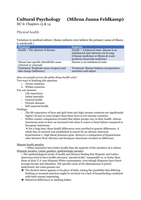Samenvatting
Summary lecture 6 Cultural Psychology
This lecture covers Chapter 13: Physical Health & Chapter 14: Mental Health of the book Cultural Psychology by Steven J. Heine. The lecture is part of the course 'Cultural Psychology' at the University of Amsterdam.
[Meer zien]





